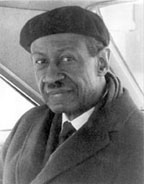James Amos Porter was the first African American art historian. Born on December 22, 1905 in Baltimore, Maryland, he was the son of Lydia and John Porter, a prominent minister in the African Methodist Episcopal (AME) Church.
Porter graduated cum laude in 1927 with a Bachelor of Science in art from Howard University. After graduating, he became an instructor of drawing and painting at Howard, teaching for 40 years, during which he was described as a gifted and influential teacher. Porter continued his education at the Art Student League in New York City, New York under Dimitri Romanovsky. Later, he met research librarian Dorothy Burnett in Harlem and married her on December 27, 1929. They had one daughter, Constance Porter.
In 1933, Porter, now an artist, received the Schomburg Portrait Prize, from the Harmon Foundation, for his piece “Woman Holding a Jug.” He continued his studies in 1935 after a fellowship from the Institute of International Education allowed Porter to study medieval archaeology at the Sorbonne in Paris, France. Afterwards, he traveled across Europe to study European and African art. When he returned to the United States, Porter earned his master’s in art history at New York University in 1937. His thesis served as the foundation for his book, Modern Negro Art, published in 1943. Modern Negro Art was the first comprehensive history of African American art and placed African American artists within the framework of American art. The book became the foundation for African American art history.
During the 1940s, Porter continued to research art and contributed to numerous publications. In 1937 he was published in “Art Front,” where he disagreed with W.E.B. DuBois and Alain Locke, stating that black artists should affirm their African heritage and still define themselves as part of American history and culture. In 1945-1946, Porter traveled to Cuba and Haiti to study Caribbean and Latin American art. There he discovered its relationship to African art and architecture. The art materials he collected during his sojourn led to the creation of Latin American art and African art and architecture curricula at Howard.
Porter retired from teaching in 1953 and became the head of Howard’s art gallery, where he displayed the work of Latin American and black artists. From 1963 to 1964, James and Dorothy Porter toured West Africa and Egypt where they visited museums, interviewed artists, and photographed over 800 works of art and architecture. Again, his research findings augmented the African art and architecture collection at Howard. Inspired by his African travels, Porter began to organize African art on canvas and held exhibition of these works in 1965 at Howard. Later that year, Porter was selected by The National Gallery of Art as one of the best art teachers in the nation. In 1966, Porter organized an exhibition for Howard’s centennial celebration, named “Ten Afro-American Artists of the Nineteenth Century,” shedding light for the first time on black artists of an earlier era.
Towards the end of the 1960s, Porter was diagnosed with cancer and became seriously ill. Despite this, he traveled to Rhodesia to chair a conference on Zimbabwean culture and, in 1970, one week before his death, he chaired a conference on African American artists.
James Amos Porter, a member of Sigma Pi Phi Fraternity, died on February 28, 1970 in Washington, D.C. at the age of 65. His second book, The Black Artist, was never completed.

